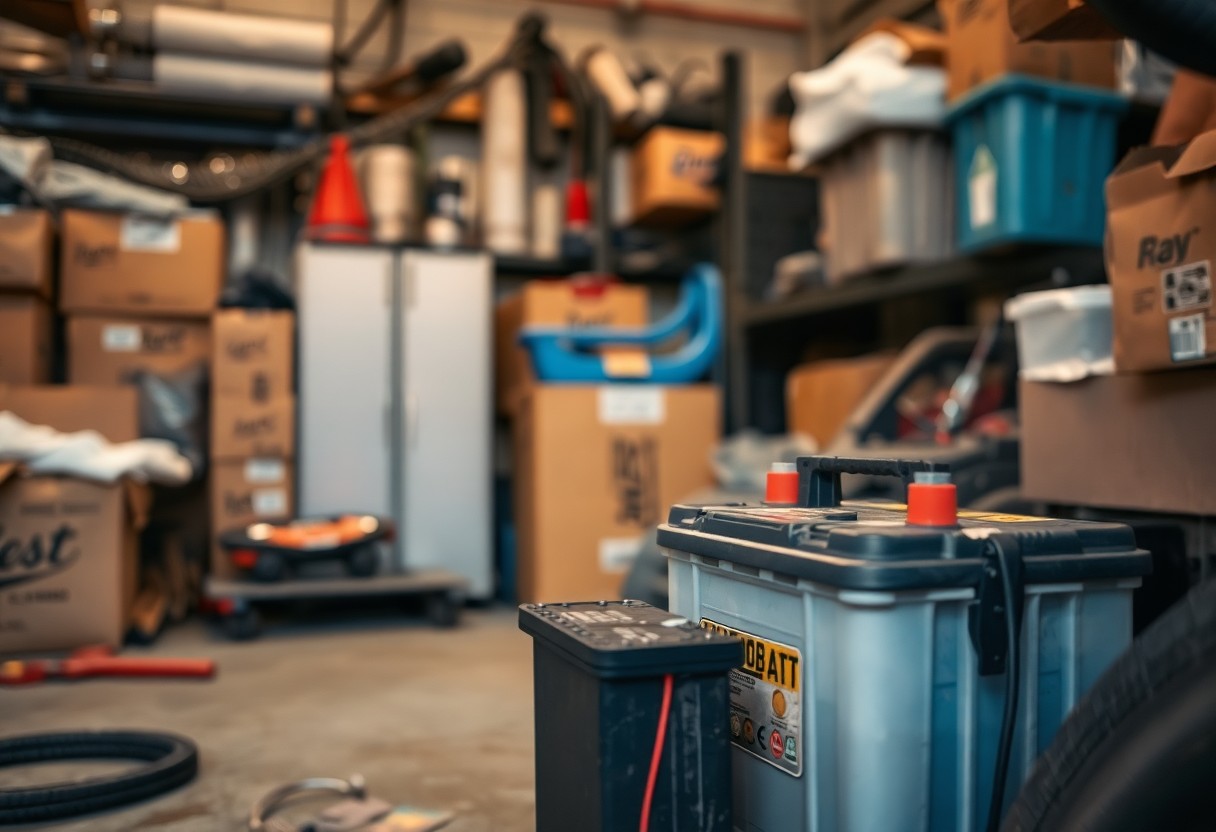Most car owners don’t realize that battery maintenance is one of the key factors in preserving your vehicle during storage periods. When your car sits idle for extended periods, its battery naturally loses charge, which can lead to costly replacements and unexpected headaches when you’re ready to get back on the road. Understanding how to maintain your car’s battery during storage isn’t just about preventing drainage – it’s about protecting your investment and ensuring your vehicle starts reliably when you need it. In this guide, you’ll learn proven methods to keep your car’s battery healthy during both short-term and long-term storage.
Key Takeaways:
- Regular battery maintenance during storage requires using a quality battery tender to maintain optimal charge levels and prevent sulfation
- Ensure proper battery disconnection if storing without a tender, and store in a climate-controlled environment to prevent temperature-related damage
- Monthly battery checks and brief vehicle starts help maintain battery health and identify potential issues early during long-term storage
Battery Preparation
While preparing your car for storage, proper battery maintenance becomes a key factor in preserving your vehicle’s starting reliability. Your battery requires specific attention to prevent drainage and maintain its capacity during extended storage periods. With proper preparation, you can extend your battery’s life and ensure your vehicle starts smoothly when needed.
Cleaning and Inspection
The first step in battery preparation involves a thorough cleaning of your battery terminals and inspection for signs of corrosion or damage. You should clean the terminals using a mixture of baking soda and water, ensuring all connections are tight and corrosion-free. Your battery’s case needs inspection for cracks or bulging, which could indicate internal damage requiring immediate replacement.
Charge Level Assessment
Assessment of your battery’s charge level is necessary before long-term storage. You can use a multimeter to check the voltage – a healthy battery should read between 12.4 and 12.7 volts. Your battery might need recharging if the reading falls below 12.4 volts, as storing a partially discharged battery can lead to sulfation and reduced performance.
It’s worth noting that modern vehicles with advanced electronics can drain a battery within 2-3 weeks of inactivity. Your best defense against battery drainage during storage is connecting a quality battery tender, which REVCity provides as part of their premium storage solutions. This device maintains optimal charge levels without risk of overcharging, ensuring your battery stays in perfect condition throughout the storage period.
Storage Environment
One of the most important aspects of battery preservation during storage is maintaining proper environmental conditions. Your car’s battery performs best and maintains its charge longer in a controlled environment that’s clean, dry, and temperature-regulated. Selecting the right storage location can extend your battery’s life by up to 50% compared to outdoor storage.
Temperature Control
| Ideal Temperature | 40°F to 60°F (4°C to 15°C) |
| Maximum Safe Temperature | 80°F (27°C) |
At these temperature ranges, your battery maintains its charge more effectively and experiences minimal internal corrosion. You should avoid exposing your battery to extreme temperatures, as heat accelerates discharge rates and cold conditions can reduce capacity by up to 20%.
Moisture Prevention
About 30% of premature battery failures are linked to moisture-related issues. You need to store your vehicle in a dry environment to prevent corrosion of battery terminals and connections. A humidity level below 50% is ideal for battery preservation.
This moisture control strategy requires proper ventilation in your storage area. You can use dehumidifiers or moisture-absorbing products to maintain optimal conditions. Your battery terminals should be clean and protected with an anti-corrosion spray to create an additional barrier against moisture damage.
Battery Maintenance Steps
Not maintaining your car’s battery during storage can lead to permanent damage and costly replacements. Your battery requires specific care to maintain its charge and prevent sulfation. Regular checks and proper maintenance can extend your battery’s life by up to 50% and save you from unexpected failures when you’re ready to drive again.
Disconnection Protocol
Between storage periods, you need to follow a proper disconnection sequence to protect your vehicle’s electronic systems. First, disconnect the negative terminal, followed by the positive terminal. Your battery terminals should be cleaned with a wire brush and coated with anti-corrosion spray to prevent oxidation during storage.
Trickle Charging Options
The right trickle charger keeps your battery at optimal charge levels without overcharging. Your modern vehicle requires a smart charger that can detect battery type and adjust charging rates automatically. These devices typically maintain a 13.2-volt charge, perfect for long-term storage conditions.
Steps for effective trickle charging include selecting the right amperage for your battery size, connecting the charger correctly (red to positive, black to negative), and monitoring the charging status through the built-in indicators. Your smart charger should be checked monthly to ensure proper operation and battery health.
Monitoring Systems
All modern vehicle storage solutions require effective monitoring to maintain battery health. Your car’s battery needs consistent attention to prevent deterioration during storage periods. Implementing a reliable monitoring system helps you track battery voltage, temperature, and overall condition, ensuring your vehicle stays ready for use whenever needed.
Regular Checks
Against common belief, visual inspections remain one of your most valuable monitoring tools. You should check your battery’s terminals for corrosion, ensure proper connection tightness, and verify electrolyte levels (in accessible batteries) every 30 days. These simple checks can help you identify potential issues before they become serious problems.
Digital Monitoring Tools
By using smart battery monitors, you can track your battery’s performance remotely. These devices connect to your smartphone, providing real-time updates about voltage levels, charging status, and temperature readings. Many models even send alerts when your battery needs attention.
In fact, modern digital monitoring tools offer features like historical data tracking and predictive analysis. You can review charging patterns, identify optimal maintenance schedules, and receive early warnings about potential battery failures. Some advanced systems even integrate with your vehicle’s onboard diagnostics to provide comprehensive health reports, helping you maintain your battery’s performance throughout the storage period.

Prevention Measures
After deciding to store your vehicle, implementing proper battery maintenance becomes imperative. You’ll need to ensure your battery maintains its charge and remains in optimal condition throughout the storage period. Regular monitoring, use of a battery tender, and proper disconnection procedures can help prevent battery degradation and extend its lifespan by up to 50%.
Corrosion Protection
Measures to protect your battery terminals from corrosion should be your priority. You can apply a specialized terminal protector spray or petroleum jelly to create a protective barrier. This simple step prevents oxidation and maintains the electrical connection quality, ensuring your battery performs efficiently when you need it.
Terminal Maintenance
At regular intervals, you should inspect your battery terminals for signs of corrosion or loose connections. Clean terminals with a mixture of baking soda and water, ensuring proper contact between the battery posts and cable connectors for optimal power transfer.
Another important aspect of terminal maintenance is checking the tightness of your battery connections every three months. You’ll want to ensure the terminals are securely fastened but not overtightened, as this can damage the battery posts. Using a wire brush to clean the terminals and applying anti-corrosion washers can extend your battery’s service life by up to 2 years.
Storage Duration Guidelines
Keep your car’s battery health in check by following proper storage duration guidelines. Different storage periods require specific approaches to maintain battery performance. Understanding these timeframes helps you implement the right maintenance strategy and prevent battery-related issues when you need your vehicle again.
Short-term Storage
One month or less of storage typically requires minimal battery maintenance. You can maintain your battery’s charge by starting your car every two weeks and letting it run for 15 minutes. This regular activation helps prevent battery discharge and keeps the charging system functioning properly.
Long-term Storage
About three months or longer of storage demands more comprehensive battery care. You need to either disconnect the battery or use a battery tender to maintain optimal charge levels. This prevents parasitic drain from your car’s electronics and helps avoid deep discharge situations that can permanently damage your battery.
Hence, if you’re planning extended storage, investing in a quality battery tender becomes crucial. These devices monitor your battery’s charge level and automatically adjust the charging rate to maintain optimal voltage. Your battery tender should provide a steady 13.2 to 13.8 volts, which prevents both undercharging and overcharging situations that could reduce battery life.
Summing up
Following this comprehensive battery care guide will help you maintain your car’s battery health during storage periods. You can significantly extend your battery’s lifespan by disconnecting it or using a quality battery tender, keeping it clean, and ensuring proper storage conditions. Your regular maintenance checks and correct storage practices will prevent unexpected failures and costly replacements. When you follow these guidelines, you’ll find your vehicle ready to start reliably whenever you need it, making your storage experience worry-free and efficient.






